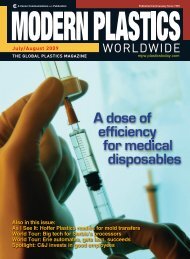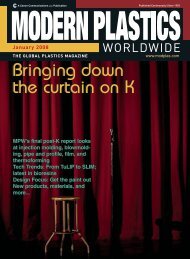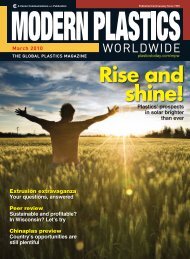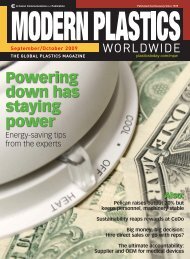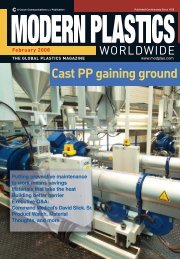amidiq - dae uptlax
amidiq - dae uptlax
amidiq - dae uptlax
You also want an ePaper? Increase the reach of your titles
YUMPU automatically turns print PDFs into web optimized ePapers that Google loves.
304<br />
J. L. Arredondo-Figueroa et al./ Revista Mexicana de Ingeniería Química Vol. 6, No. 3 (2007) 301-308<br />
Table 3. Average values (standard deviation) of physicochemical parameters<br />
and nitrogenous compounds registered during the experiment.<br />
Load rate (kg) Sample<br />
points<br />
pH T (°C) D.O<br />
(mg/l)<br />
TAN<br />
(mg/l)<br />
NH3<br />
(mg/l)<br />
194 FT 8.5<br />
ST<br />
BI<br />
RT<br />
a<br />
(0.17)<br />
8.5 a<br />
(0.13)<br />
8.4 a<br />
(0.08)<br />
8.5 a<br />
20.5<br />
(0.07)<br />
a<br />
(1.0)<br />
20.5 a<br />
(1.2)<br />
20.4 a<br />
(1.0)<br />
19.6 a<br />
6.4<br />
(1.0)<br />
a<br />
(1.8)<br />
4.6 b<br />
(1.7)<br />
5.8 a<br />
(1.8)<br />
7.2 a<br />
1.96<br />
(2.6)<br />
a<br />
(0.69)<br />
1.03 b<br />
(0.28)<br />
0.36 c<br />
(0.09)<br />
0.26 c<br />
0.11<br />
(0.06)<br />
a<br />
(0.04)<br />
0.07 a<br />
(0.02)<br />
0.01 b<br />
(0.01)<br />
0.02 b<br />
(0.01)<br />
156 FT 8.5<br />
ST<br />
BI<br />
RT<br />
a<br />
(0.17)<br />
8.4 a<br />
(0.13)<br />
8.3 a<br />
(0.08)<br />
8.5 a<br />
19.1<br />
(0.07)<br />
a<br />
(1.0)<br />
19.0 a<br />
(1.2)<br />
19.0 a<br />
(1.0)<br />
19.0 a<br />
7.7<br />
(1.0)<br />
a<br />
(1.8)<br />
5.9 b<br />
(1.7)<br />
6.1 a<br />
(1.8)<br />
7.0 a<br />
1.73<br />
(2.6)<br />
a<br />
(0.33)<br />
0.91 b<br />
(0.19)<br />
0.37 c<br />
(0.14)<br />
0.22 c<br />
0.08<br />
(0.08)<br />
a<br />
(0.02)<br />
0.06 a<br />
(0.02)<br />
0.01 b<br />
(0.01)<br />
0.01 b<br />
(0.01)<br />
89 FT 8.6<br />
ST<br />
BI<br />
RT<br />
a<br />
(0.17)<br />
8.5 a<br />
(0.13)<br />
8.3 a<br />
(0.08)<br />
8.6 a<br />
18.9<br />
(0.07)<br />
a<br />
(1.1)<br />
19.6 a<br />
(1.2)<br />
18.9 a<br />
(1.0)<br />
18.0 a<br />
7.0<br />
(1.0)<br />
a<br />
(1.8)<br />
5.4 b<br />
(1.7)<br />
6.3 a<br />
(1.8)<br />
7.4 a<br />
1.27<br />
(2.6)<br />
a<br />
(0.42)<br />
0.64 b<br />
(0.08)<br />
0.25 c<br />
(0.05)<br />
0.22 c<br />
0.07<br />
(0.04)<br />
a<br />
(0.02)<br />
0.05 a<br />
(0.01)<br />
0.01 b<br />
(0.01)<br />
0.01 b<br />
(0.01)<br />
a,b,c<br />
Different superscript letters in columns, mean significant differences (p ≤ 0.05)<br />
FT = Fish tank; ST = Settling tank; BI = Biofilter; RT = Reconditioning tank.<br />
Preliminary tests results showed that all<br />
requirement for a good nitrification rate in a wellaerated<br />
culture system were fulfilled in this study;<br />
presence of ammonia, dissolved oxygen, trace<br />
nutrients, and a relative low level of organic carbon<br />
in the biofilter. During the experimental period,<br />
average water temperature varied between 18.0 and<br />
20.5 °C. The highest values were registered during<br />
the first phase of the experiment with no significant<br />
differences (p ≥ 0.05) among sampling sites and<br />
phases (Table 3). However, average temperature at<br />
the reconditioning tank (RT) in the first phase was<br />
slightly lower with respect to other sampling sites.<br />
Dissolved oxygen fluctuated from 4.6 to 7.7<br />
mg/l, the lowest values were observed in the settling<br />
tank (ST), due that all wastes were accumulated and<br />
concentrated in this site. Significant differences (p ≤<br />
0.05) were observed among sampling sites<br />
particularly in the ST, and it can be attributed to an<br />
increase in water temperature. Oversaturated values<br />
were registered in the fish tank (FT) and<br />
reaconditioning tank (RT), where a vigorous aeration<br />
was maintained throughout the experiment.<br />
However, average oxygen concentration was 6.4<br />
mg/l, a larger value than that required for complete<br />
oxidation. Therefore, it can be assumed that it is<br />
necessary to maintain an optimum growth and<br />
survival rate of the rainbow trout (Klontz, 1991).<br />
NO2 -<br />
(mg/l)<br />
0.44 a<br />
(0.22)<br />
0.64 b<br />
(0.26)<br />
0.41 a<br />
(0.22)<br />
0.24 c<br />
(0.15)<br />
0.41 a<br />
(0.10)<br />
0.61 b<br />
(0.14)<br />
0.40 a<br />
(0.10)<br />
0.25 c<br />
(0.12)<br />
0.44 a<br />
(0.10)<br />
0.59 b<br />
(0.19)<br />
0.32 c<br />
(0.15)<br />
0.28 c<br />
(0.13)<br />
NO3 -<br />
(mg/l)<br />
25.9 a<br />
(4.5)<br />
24.5 a<br />
(2.6)<br />
24.9 a<br />
(3.4)<br />
23.5 a<br />
(3.1)<br />
28.6 a<br />
(3.4)<br />
27.5 a<br />
(2.8)<br />
27.2 a<br />
(2.2)<br />
27.0 a<br />
(3.6)<br />
26.9 a<br />
(4.6)<br />
22.7 b<br />
(9.0)<br />
23.3 b<br />
(8.3)<br />
25.5 b<br />
(3.5)<br />
Results in Table 3 agreed with those reported<br />
by Kruner and Rosenthal (1987) and Michaud et al.,<br />
(2006) for fish culture systems. pH values were<br />
almost constant throughout the experiment with<br />
minor variations. These values had no significantly<br />
differences (p ≥ 0.05) between sampling sites and<br />
phases. Nitrification depends on the release of<br />
inorganic nitrogen compounds from organic matter<br />
usually degraded by heterotrophs. Normally,<br />
nitrification rates are strongly influenced by pH. Srna<br />
and Baggaley (1975) observed that the establishment<br />
of nitrifying bacteria and conditions in which they<br />
grow determine their response to pH changes.<br />
Optimum pH for complete nitrification is circa 7.45,<br />
effective nitrification is achieved within a pH range<br />
of 7.0 to 8.2. Wild et al. (1971) reported that the<br />
optimum pH for nitrification in freshwater was 8.4,<br />
which coincides with the value found in our study.<br />
Total ammonia nitrogen (TAN) range was<br />
between 0.22 and 1.96 mg/l. The higher load fish<br />
rate (194 kg) coincides with higher TAN value.<br />
Significant differences (p ≤ 0.05) were observed<br />
among load fish rates, with highly significant<br />
differences in fish and settling tanks. Total ammonia<br />
oxidation in the three load rates was similar<br />
throughout the study meaning that metabolism of<br />
nitrifying microorganisms were near their maximum<br />
(Table 3). No adverse effects were observed on the




